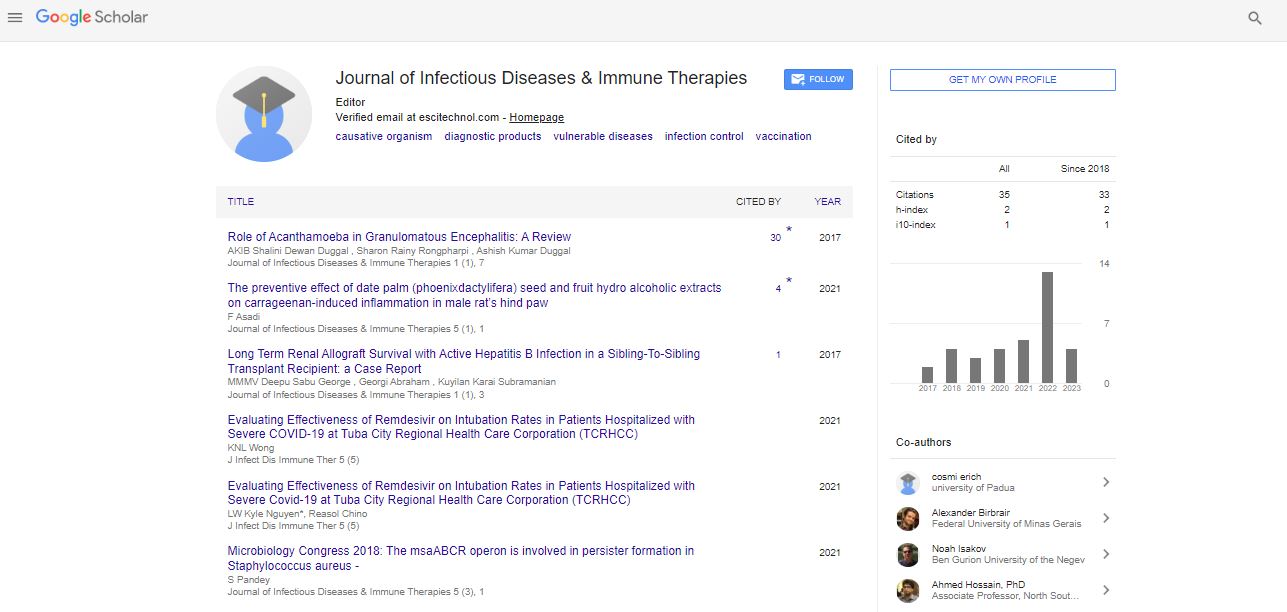Perspective, Vol: 12 Issue: 2
Hepatitis: The Causes, Types, Symptoms, and Therapeutic Approaches
Kanika Elizabeth*
Department of Molecular Biology, University of California San Diego, La Jolla, USA
*Corresponding Author: Kanika Elizabeth
Department of Molecular Biology,
University of California San Diego, La Jolla, CA 92093, USA
E-mail: kanikaeilza@ucsd.edu
Received date: 27 May, 2023, Manuscript No. JIDITH-23-106356;
Editor assigned date: 29 May, 2023, Pre QC No. JIDITH-23-106356 (PQ);
Reviewed date: 15 June, 2023, QC No. JIDITH-23-106356;
Revised date: 23 June, 2023, Manuscript No. JIDITH-23-106356 (R);
Published date: 30 June, 2023, DOI: 10.4172/2329-9541.1000344
Citation: Elizabeth K (2023) Hepatitis: The Causes, Types, Symptoms, and Therapeutic Approaches. J Immunol Tech Infect Dis 12:2.
Description
Hepatitis is a widespread inflammatory condition that affects the liver, causing damage and dysfunction. It can be caused by various factors, including viruses, toxins, and autoimmune responses. This provides an in-depth overview of hepatitis, covering its different types, causes, symptoms, and available treatment options. Understanding hepatitis is crucial for early detection, prevention, and effective management of this potentially serious condition.
Hepatitis is a significant global health concern, affecting millions of people worldwide. This aims to provide a comprehensive understanding of hepatitis, its causes, types, symptoms, and available treatment options. By shedding light on this condition, we hope to increase awareness and promote early diagnosis and effective management.
There are several types of hepatitis, classified as viral and non-viral. Viral hepatitis includes Hepatitis A, Hepatitis B, Hepatitis C, Hepatitis D, and Hepatitis E. Each type is caused by a specific virus and exhibits distinct characteristics. Non-viral hepatitis can result from autoimmune reactions, drug or alcohol abuse, metabolic disorders, or exposure to certain toxins.
Hepatitis can be caused by viral infections, exposure to toxins, or autoimmune responses. Hepatitis A and E are typically transmitted through contaminated food or water, while Hepatitis B, C, and D primarily spread through blood-to-blood contact, sexual contact, or sharing contaminated needles. Non-viral hepatitis may be triggered by excessive alcohol consumption, certain medications, metabolic disorders, or autoimmune diseases.
The symptoms of hepatitis can vary depending on the type and stage of the condition. Common symptoms include fatigue, jaundice, and abdominal pain, loss of appetite, nausea, and dark urine. Chronic hepatitis can lead to serious complications such as cirrhosis, liver failure, hepatocellular carcinoma, and death. It is essential to recognize these symptoms and seek medical attention for early diagnosis and appropriate management.
Accurate diagnosis of hepatitis involves a combination of clinical evaluation, blood tests, imaging studies, and liver biopsy. Blood tests can detect specific viral markers, assess liver function, and determine the extent of liver damage. Imaging techniques such as ultrasound, Computed Tomography (CT), or Magnetic Resonance Imaging (MRI) help evaluate the liver's structure and identify any abnormalities.
The treatment for hepatitis varies depending on the type and severity of the condition. Acute viral hepatitis often resolves on its own with supportive care, including rest, adequate hydration, and a balanced diet. Chronic viral hepatitis may require antiviral medications to suppress viral replication and reduce liver inflammation. In some cases, liver transplantation becomes necessary for end-stage liver disease or liver failure. Non-viral hepatitis management involves treating the underlying cause, such as alcohol cessation, medication adjustments, or immunosuppressive therapy for autoimmune hepatitis.
Preventing hepatitis involves a combination of vaccination, practicing safe hygiene measures, and adopting safer sexual practices. Vaccines are available for Hepatitis A and B, offering effective protection. Safe food and water practices, such as proper hand washing and avoiding consumption of raw or undercooked foods, can help prevent Hepatitis A and E. Safe injection practices and harm reduction strategies play a vital role in reducing the transmission of Hepatitis B, C, and D. Public health initiatives should focus on increasing vaccination coverage, promoting awareness, and implementing preventive measures to reduce the burden of hepatitis.
Hepatitis is a significant public health concern worldwide. Understanding the different types, causes, symptoms, and treatment options is crucial for early detection, prevention, and effective management. By promoting vaccination, safe hygiene practices, and appropriate medical interventions, we can mitigate the impact of hepatitis and improve the quality of life for those affected by this condition.
 Spanish
Spanish  Chinese
Chinese  Russian
Russian  German
German  French
French  Japanese
Japanese  Portuguese
Portuguese  Hindi
Hindi 